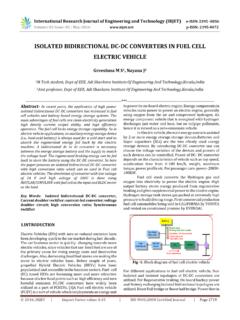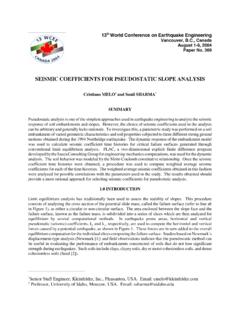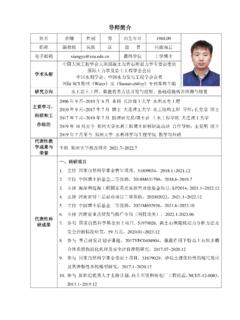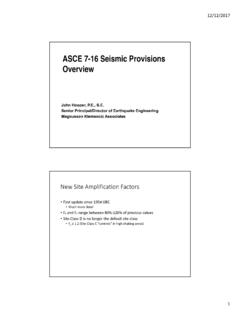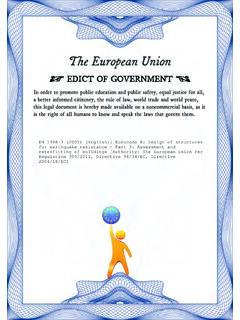Transcription of Design and Analysis of Residential Building using E-TABS
1 International Research Journal of Engineering and Technology (IRJET) e-ISSN: 2395-0056 Volume: 05 Issue: 05 | May-2018 p-ISSN: 2395-0072 2018, IRJET | Impact Factor value: | ISO 9001:2008 Certified Journal | Page 942 Design and Analysis of Residential Building using E-TABS S Abhishek1, Manoj S K2, Roopa B D3, Bhagyashree M S4, Guruprasad C H M5 1,2,3,4 Student, Department of Civil Engineering, Institute of Technology. Ranebennur, Karnataka, India 5 Assistant Professor, Department of Civil Engineering, Institute of Technology. Ranebennur, Karnataka, India ---------------------------------------- -----------------------------**--------- ---------------------------------------- --------------------Abstract - ETABS stands for Extended Three Dimensional Analysis of Building Systems.
2 The main purpose of this software is to Design multi-storeyed Building in a systematic process. The effective Design and construction of an earthquake resistant structures have great importance all over the world. This project presents multi-storeyed Residential Building analysed and designed with lateral loading effect of earthquake using ETABS. This project is designed as per INDIAN CODES- IS 1893-part2:2002, IS 456 Every structural engineer should Design a Building with most efficient planning and also be economical. They should ensure that it is serviceable, habitable in healthy environment for its occupants and have longer Design period. Structurally robust and aesthetically pleasing Building are being constructed by combining the best properties of any construction material and at the same time meeting specific requirements like type of Building and its loads, soil condition, time, flexibility and economy.
3 In the view of above, the high rise buildings are best suited solution. This paper discusses the Analysis of a commercial Building (G+1) located at Hyderabad under effect of Seismic forces. Shear forces and bending moments of beams and columns are observed and concluded that larger span have more shear forces and bending moment. Key Words: Structural Design , ETABS, Shear forces, Bending moments. 1. INTRODUCTION ETABS is a sophisticated, yet easy to use, special purpose Analysis and Design program developed specifically for Building system. ETABS version features an intuitive and powerful graphical interface coupled with unmatched modeling, analytical, and Design procedures, all inte-grated using a common database. Although quick and easy for simple structures, ETABS can also handle the largest and most complex Building models, including a wide range of nonlinear behaviors, making it tool of choice for structural engineers in the Building industry.
4 Dating back more than 30 years to the original development of ETABS, the predecessor of ETABS, it was clearly recognized that buildings constituted very special class structures. Early releases of ETABS provide input, output and numerical solution techniques that took into consideration and characteristics unique to Building type structure , providing a tool that offered significant savings in time and increased accuracy, over general purpose programs. As computers and computer interfaces evolved, ETABS added computationally complex analytical options such as dynamic nonlinear behavior, and powerful CAD-like drawing tools in a graphical and object based interface. Most Building is of straightforward geometry with horizontal and vertical beams and vertical columns. Although any Building configuration is possible with ETABS, in most cases, simple grid system defined by horizontal floors and vertical column lines can establish Building geometry with minimal effort.
5 Design PHILOSOPHIES There are three philosophies for the Design of reinforced concrete namely: 1) Working stress method 2) Ultimate load method 3) Limit state method STAGES IN STRUCTURAL Design 1) Drawing Study 2) Load Combinations 3) Analysis Of Structures 4) Structural Design 2 OBJECTIVE Following are the objectives 1. Modeling the Building using the software ETABS 2. Applying gravity loads and different load combinations as per Indian codal provision. 3. Analysing and designing of Residential Building (G+1) for worst case of load combination International Research Journal of Engineering and Technology (IRJET) e-ISSN: 2395-0056 Volume: 05 Issue: 05 | May-2018 p-ISSN: 2395-0072 2018, IRJET | Impact Factor value: | ISO 9001:2008 Certified Journal | Page 943 3.
6 Plan of Residential Building Table -1: SILENT FEATURE OF PROPSED Building : Description Features 1 LOCATION BANGLORE 2 TYPE OF Building G+1 3 structure . FRAME 4 BUILT UP AREA 140 m2 5 HEIGHT B/W THE FLOOR m 6 DEPTH OF FOUNDATION BELOW m 7 PRIMARY AND SECONDARY WALL THICKNESS 230, 115 mm 4. Analysis Methods Etab is the premier FEM Analysis and Design tool for any type of project including towers, culverts, plants, bridges, stadiums, and marine structures. With an array of advanced Analysis capabilities including linear static, response spectra, time history, cable, and pushover and non- linear analyses, Etab provides good compatibility with a scalable solution that will meet the demands of project every time. Preparation of plan in Autocad Importing to Etabs Building modeling in Etabs Defining and assigning of materials Manual Design (as per IS456-2000 SP-16) Assigning loads as per IS 456-2000 Analyse the Building model Check results Design using Etabs software comparison conclusion Fig -1: METHODOLYGY 5.
7 Analysis RESULT Fig-2:3D MODEL International Research Journal of Engineering and Technology (IRJET) e-ISSN: 2395-0056 Volume: 05 Issue: 05 | May-2018 p-ISSN: 2395-0072 2018, IRJET | Impact Factor value: | ISO 9001:2008 Certified Journal | Page 944 Fig-3: BENDING MOMENT DIAGRAM Fig-4: Shear force diagram from Etab 6. Design DETAILS Design of slab 1 Lx= m Ly= m LY/Lx = < 2 (Hence slab designed as two way ) Total load on slab = kN/m2 Factored moment =10 Kn-m Assuming depth of slab = 150 mm Design of the as under reinforced Slab cover =25 mm Bend the alternative bars@ a distance of L/7 from the face of the wall = / 7= m Assuming dia 8mm 150 c/c (main reinforcement) Distribution reinforcement Ast min as distribution reinforcement = % *b*D = %*1000*150 =180 mm2 Sapcing of 10 mm dia = ( *102 *100)/180 = 200 mm Provide 8 mm dia @ 150 mm c/c Check for deflection: Assuming span to depth ratio = L/d < 20 = <20 = < 20, Hence safe.
8 Design of Slab 2: LY = m , LX = m, Aspect ratio (ly/ lx) = = < 2 (hence two way slab two edges discontinuous , two edge continuous x y MX =x * w*LX2 My=Y * w*LX2 Dia spacing x Dia spacing y -ve reinforcement - kN .m - 8 dia @200 mm c/c 8 dia @150 mm c/c +ve reinforcement 8 dia @150 mm c/c 8 dia @150 mm c/c Design of slab 3: LY = m , LX = m, Aspect ratio (ly/ lx) = < 2 (hence two way slab ) One short edge discontinuous. x y MX =x * w*LX2 My =Y * w*LX2 Dia spacing x Dia spacing y -ve reinforcement 10 dia 200 mm c/c 8 dia 180 mm c/c +ve reinforcement 8 dia 180 mm c/c 8 dia 180 mm c/c Slab 6: Lx= , Ly = , aspect ratio ( Ly/LX )= > 2 , one way slab ) Total load on slab = kN/m2 MX= w *Lx2 / 8 = ( * 2)/8 = Factored moment = * = 10 Assuming 8 dia @ 270 mm c/c (main reinforcement) Distribution reinforcement Ast as distribution reinforcement = %*1000*150 =180 mm2 Spacing of 6 mm dia = *62*1000/(4*180) = 150 mm So, provide 8 mm dia @ 150 c/c.
9 Check for deflection: Assuming span to depth ratio = L/d < 20 = <20 = < 20, Hence safe International Research Journal of Engineering and Technology (IRJET) e-ISSN: 2395-0056 Volume: 05 Issue: 05 | May-2018 p-ISSN: 2395-0072 2018, IRJET | Impact Factor value: | ISO 9001:2008 Certified Journal | Page 945 7. Design OF BEAM Data Grid beam no 1-A Characteristic compressive strength of concrete = fck = 20 N/mm2 Characteristic strength of steel = fy = 500 N/mm2 Adopt d = 400 mm D = 450 mm b = 230 mm Length = L = m From Etab results, Negative moment at interior support, Mu = 55 kN-m Positive moment at center of span, Mu = 43 kN-m Maximum shear force at support section, Vu = 50 KN Main reinforcement For -ve , Mu = fyAstd[1- Astfy/bdfck] 55x106 = [1- Astx500/230x450x20] Ast = mm2 Provide 2 bars of 12 mm dia and 2 bars of 10mm dia (Ast=380mm2) @ top tension face near supports For +ve , Mu = fyAstd[1- Astfy/bdfck] 43x106 = [1- Astx500/230x450x20] Ast = 300 mm2 Provide 3 bars of 12 mm dia (350 mm2) at bottom tension face at centre of span section.
10 Shear reinforcement, = vu/ b d = 50x103/230x450 = N/mm2 Pt = 100x Ast / b d = 100x350 / 230x450 = % Refer table 19 (IS 456) read out, = N/mm2 Hence shear reinforcement is required. Vus = vu - b d =50 ( )103 = kN Use 8 mm dia two legged stirrups, the spacing is, Sv = ( d) / Vus = ( 500 x 50 x 450) / Sv = 250 mm Adopt 8 mm dia two legged stirrups @ 220 mm c/c Check for deflection, At centre of span: Pt = 100 Ast / b d = 100x350 / 230x450 = % From fig,4 of IS 456 , Kt = , Kc =1 ,Kf =1 (L/d) max = (L/d) basic x Kt x Kf =26 x x 1 = (L/d) actual = 7600/450 = (L/d) actual < (L/d) max Hence deflection control is satisfied 8. Design OF COLUMNS Data, Characteristic compressive strength of concrete = fck = 20 N/mm2 Characteristic strength of steel = fy = 500 N/mm2 Pu = 250 KN (taken from Etab) b = 230 mm D= 350 mm Length = L = 3100 mm Longitudinal reinforcement = Pu = * fck *AC + * fy * Asc = * fck *Ag + ( *415 *20 )*Asc 250*103= *20*230*350 + ( * *20)*Ast Ast = 1200 mm2 So , Pt min = Ast = mm2 Provide # 4 bars of 16 mm diameter Design of lateral ties Tie diameter So , provide lateral reinforcement 8mm ties Tie spacing St So , provide tie spacing at 8mm @ 230 mm c/c Design of uniaxial column PU = 164 kN Muz= 10 Width =b =230 mm Depth = d= 350 mm d'/D = PU/(fck *b*D) = 164*103/(20*230*350) = MU/(fck *b*D2)= 10*106/(20*230*3502)= AST min = (from SP 16 code ) P/fck = (minimum) P= *20= Area of steel = ( *230*350)







